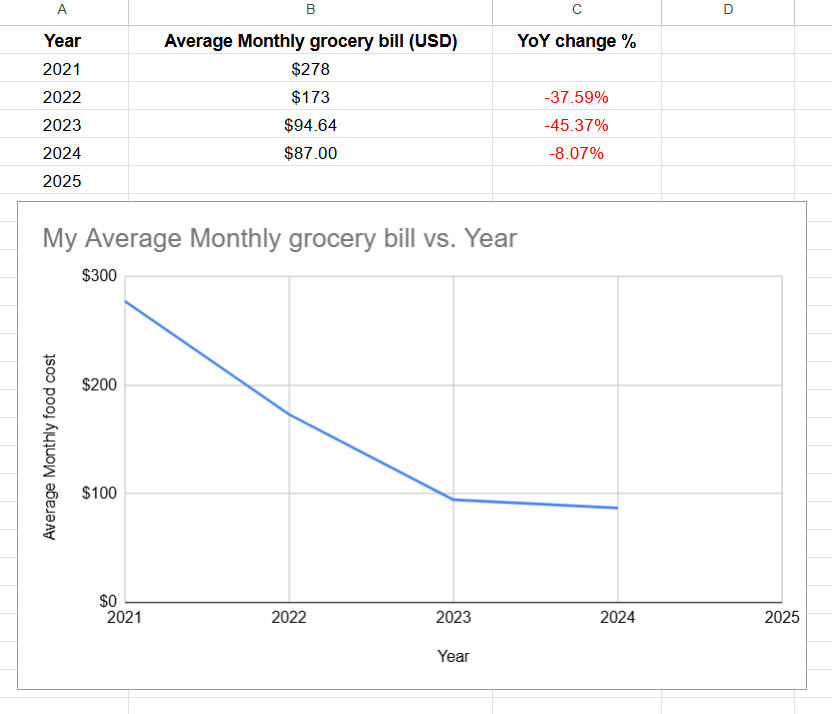Many people are struggling with high grocery bills. Grocery bills are a big part of most households’ budget and every small grocery item can quickly add up significantly each month. However, there are ways to lower them or at least prevent them from growing out of control. I’ll explain below.
According to USDA, U.S. consumers spent an average of 11.2 percent of their disposable personal incomes on food in 2023. In contrast, I spent only 5.5% of my disposable income on food in 2024.
Since 2021, we experienced high food inflation. Food inflation in US reached as high as 11% Year over Year in 2022. Yes, the year over year change has come back down to 2% in 2024 but it’s still going up. It’s just going up slower. The price has not decreased. It’s a lot higher than 2021!

5 year US food inflation
Chart: Source Trading Economic
Data source: US BLS
In the backdrop of high food inflation, I’ve managed to lower my grocery bill from $278/m in 2021 to $87/month in 2024.

How?
Before high food inflation kicked in, I used to buy food randomly. I was buying whatever I want. I was buying all kinds of snacks and exotic fruits imported from around the world. (Hint: expensive.) After 2021, I’ve paid more attention to cost and cut it down substantially. If you want to lower grocery bills, I’ll explain below. I don’t think people should copy me 100% but I hope to give some inspirations.
Keep track of grocery receipt
I started to keep track of grocery item costs on a Google Drive spreadsheet. Initially, I only wrote down the unit price. Later, I recorded more data: unit weight, and price per unit weight. Then I added up the total per store visit, per month, per year, etc. Tracking item costs not only ensures we are buying at the best price, it forms a baseline monthly budget which will keep it hovering around similar levels throughout the years.
Here’s the link for the template of spreadsheet I used:
https://docs.google.com/spreadsheets/d/1-qtMiJRLIKdefbOYJWcWfVlPOBy3fQFGqEH5kuKlR6w
![]()
Stick with a shopping list
Before you go to the grocery store, plan ahead. Check the inventory of necessary foods you regularly buy, and see what is running low, then put them on a shopping list, check flyers, online prices. Compare with the historical unit cost per unit weight on the grocery bill tracker spreadsheet.
The problem with overspending on grocery is because when we browse randomly in the store, we grab items we don’t need that look interesting. By planning with a shopping list, you will only buy what you need, not unnecessary items you see in the store which you don’t need that can quickly add up. I remember the random expensive food I consumed. It made no difference to my health. Our body only takes what it needs. Any extra will go right out. By sticking with a shopping list, you will also save time and transportation cost because you don’t make as many trips to the store.
Buy on sale
I keep an eye on the weekly flyers. If I see items go on sale that I need, I will load up. Food items frequently go on sale: vegetables, fruits because they go bad quickly. For vegetables, I buy one month’s worth and freeze the extra after washing and cutting. I also freeze milk. It tastes and feels the same after thawing. For fruits, I buy apples, and oranges. They last 1 month in the fridge.
Avoid processed foods
Processed foods are a lot more expensive than raw ingredients. If you pay attention to price/unit weight, for example, bread is a lot more expensive than all-purpose flour. Yeah, one loaf of bread only costs a few bucks each and if we multiply it by 4 is only 10 bucks per month. But combining all items, they add up.
One meal a day
I’ve been eating one large and nutrient-dense meal a day around the noon. Surprisingly, I don’t feel hungry at night. When I was eating 3 meals, I usually felt hungry if I stay up late at night.
This diet is extreme and most people shouldn’t do it. At least, what they can do is don’t eat heavily at night. I do this because it not only saves money and reduces food waste. If we try to eat a lot of food not needed by our body, it makes no difference to the health of the body. It’s either turned into fat or simply passed through the body. With the increasing rate of obesity, avoiding over eating helps us minimize chance of getting diabetes, heart disease, etc. Research shows it may also prolong lifespan with intermittent fasting, calorie restriction.
Buying in bulk
Buying in bulk is all about lowering cost per unit weight or volume. I used to buy 1L milk. Now, I buy 4L milk. It’s a lot cheaper. For carbs, I buy a huge 20kg all-purpose flour bag which lasts me for 2 months. I buy 10 Kg dry split pea beans that can last me a few months. For some items, I have to go to wholesale stores such as Costco: e.g. 20 kg all purse flour, 10 kg split peas. For large packages, we can’t find them in regular grocery stores. It’s worth it to pay the membership fee.
Focus on unit price per unit weight
Notice how deceiving it can be to buy based on unit price? If it’s $1/broccoli but what its weight is? If a store sells based on unit price without weight, I normally avoid it because I can’t tell its unit price per lb. or per kg or per 100 grams. The biggest secret to lower grocery bills is to minimize the unit price per unit weight or volume. KEEP this in mind whenever you shop. Most people don’t pay attention to this so their food expenses are out of control.
If you pay attention, for example, you’ll notice rice is 2-3 times more expensive than all-purpose flour. So I eat less rice and eat more all-purpose flour. Generic brands are also cheaper per unit weight than name brands. Most of the time, it makes no difference in quality. It’s usually made by the same factory with different labels. By focusing on unit price per unit weight, we are automatically buying for good reasons. E.g., Fruits and veggies go on sale because they are in season, over-supplied or near expiration.
Be vegan or eat less meat
From my experience, even with bulk purchases, meat protein is at least 6 times more expensive than plant protein. The cheapest protein source is: dry split peas. After soaking, they increase in size which lowers its cost per unit weight. In my area, dry split peas are dirt cheap: 50 cents per lb!
Minimize eating out
It’s all about unit prices per unit weight. Eating out frequently is very expensive! So don’t buy too much take-out food or restaurant food.
Grow/make our own food
In my backyard, I have two grapevines that produce grapes each year to supply fresh grapes from August to September. It’s super delicious. It’s low maintenance. I don’t have to do much except cut it back once per year. I also have a raised bed garden to grow fresh green-leaf veggies for a few months in the summer. Here, it snows in the winter so I can’t grow year round. Indoor, I will make some beansprout. It takes just 7 days to grow mungbean(green bean) sprout. Mungbean is best for sprouting because its seeds are small. The sprout yield is much higher than soybean. I did not find success sprouting soybeans.
I also make lots of DIY food such as breads, cookies, pita bread, buns, etc from a 20kg bag of all-purpose flour which costs just $14 per bag or 70 cents/kg from wholesale store. Many people think they don’t have time to cook their own food but if they cook in big batches. It doesn’t take much time. For example, I make one batch of pita bread which lasts me 2 weeks. Making pita bread twice a month is not too bad!

Relax it once in a while
Occasionally, I do eat food that’s not cost-effective nor healthy once in a while. For example, I eat instant noodles once per month which cost 50 cents per 80 grams. Unit price wise, it’s very expensive. $6/kg vs $1/kg all purse flour. But I like to taste it occasionally but it won’t add a lot to monthly expenses. I also like sweet potato once in a while!
In the end,
Incorporating these strategies may sound daunting and takes some effort but the savings are well worth it!
I don’t think everyone can or should be as aggressive as I did to lower grocery bills but I think it’ll improve their monthly food cost if they can use some of the tips above. What good is high income if living paycheck to paycheck? To increase net worth, it’s not how much we make but how much we keep each month.
